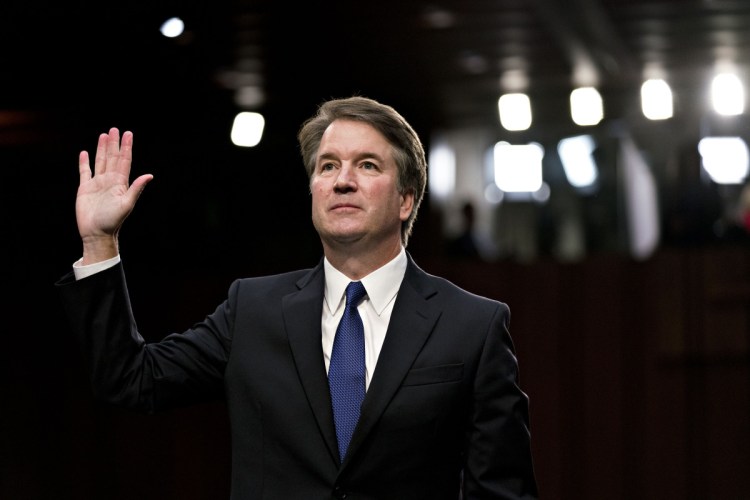WASHINGTON — Republicans and Democrats sharply disagreed on whether Judge Brett Kavanaugh should join the Supreme Court, but across party lines, most agreed on what his appointment means.
A Justice Kavanaugh, who would be President Trump’s second appointee on the high court after Justice Neil Gorsuch, will almost surely create a significantly more conservative majority on the Supreme Court and shift the law to the right on a wide front – from abortion and affirmative action to environmental protection, gun rights, immigration, property rights and religion.
The justices also are being asked in pending appeals to decide whether federal law bars job discrimination on the basis of sexual orientation and gender identity. In addition, they could soon be drawn into the fight over Trump’s effort to rescind deportation protections for young undocumented immigrants.
And before long, the court could be confronted with special counsel Robert Mueller’s investigation of Russian interference in the 2016 election and possible obstruction of justice by Trump. The Supreme Court has never said whether a president must obey a subpoena to testify in a criminal investigation.
The pace of change will depend largely on Chief Justice John G. Roberts Jr., who has talked about the importance of stability in the law and of preserving the perception that the court is not following a political agenda.
“It is quite possible we will have not just a conservative court, but an aggressively conservative court – a court that would not merely refrain from protecting civil rights, but one that may be poised affirmatively to strike down progressive state and federal laws and regulations for decades to come,” said Walter Dellinger, who served as President Clinton’s top Supreme Court lawyer.
NO SWING VOTE
For the last 30 years, the court’s center has been defined by the views of two moderate Republicans: Justices Sandra Day O’Connor and Anthony M. Kennedy. They leaned to the right in cases involving business, crime, job discrimination or government power, but at times, they joined with the liberals.
Kennedy played the key role in recognizing gay rights, for example. And both were wary of pushing the law too far to the right. Most famously, they balked in 1992 when fellow conservatives tried to overturn the abortion right set forth in Roe vs. Wade.
In 2006, O’Connor retired and was replaced by a much more conservative jurist, Justice Samuel A. Alito Jr. Now, the court will have five conservative Republican appointees and four liberal Democratic appointees – and no apparent swing vote.
In Kavanaugh’s years on the U.S. Court of Appeals for the District of Columbia Circuit, he regularly took the most conservative position on three-judge panels.
And if he was a staunch conservative at the time of his nomination in July, the fierce partisan fight over his confirmation makes it even less likely he will play a moderating role.
Kavanaugh’s arrival also likely will bolster the Trump administration in its effort to fend off at least three significant legal challenges that are winding their way to the Supreme Court.
One involves the president’s decision to repeal the Obama-era order that shields the so-called Dreamers – immigrants who arrived in the U.S. illegally as children. A second challenges the Commerce Department’s decision to add a question on citizenship to the 2020 census, a move that California’s lawyers say could lead to an undercount of the population. In the third case, lawyers for transgender members of the military, and other transgender people who want to enlist, are fighting the White House’s order to sharply restrict their ability to serve.
In all three cases, lower-court judges have blocked the administration, at least temporarily, and Trump’s lawyers are trying to get cases before the Supreme Court in this year’s term.
WHAT’S AT ISSUE
For many pro-business conservatives, the most talked-about issue on the agenda for a more conservative court is reining in the “administrative state” and the regulations that arise from federal agencies. Progressives praise rules that protect the environment, consumers, workers and investors from corporations and Wall Street; conservatives complain about dense and costly rules that are handed down by unelected bureaucrats.
On the appeals court, Kavanaugh was a strong advocate for giving the president and judges more power to restrain government regulations.
For social conservatives, abortion and religious liberty remain the top issues. Within a year or so, the court is likely to face a decision on whether to overturn or scale back the right to abortion.
Now, with Kennedy gone and Kavanaugh sitting as his replacement, antiabortion lawyers in conservative states will press to prohibit abortion.
Those laws will almost surely be struck down by federal judges because they violate Roe vs. Wade. But the eventual appeal will then head to the Supreme Court, forcing the chief justice and his colleagues to confront the issue that has rallied conservatives since the 1980s and helped elevate them to the Supreme Court.
This report includes material from Greg Stohr of Bloomberg News.
Send questions/comments to the editors.



Success. Please wait for the page to reload. If the page does not reload within 5 seconds, please refresh the page.
Enter your email and password to access comments.
Hi, to comment on stories you must . This profile is in addition to your subscription and website login.
Already have a commenting profile? .
Invalid username/password.
Please check your email to confirm and complete your registration.
Only subscribers are eligible to post comments. Please subscribe or login first for digital access. Here’s why.
Use the form below to reset your password. When you've submitted your account email, we will send an email with a reset code.